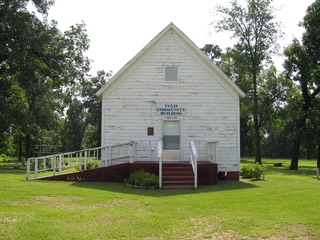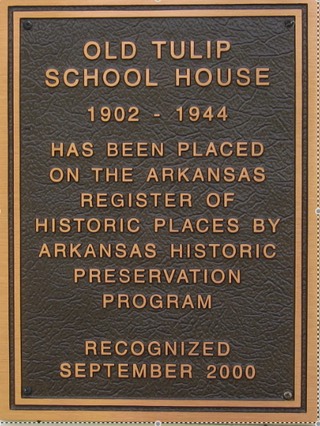In the early 1840s, a French women, named Madame D'Estimarille, opened a school for Ladies in Tulip. Wealthy planters from Louisiana, started to send their daughters to the school, and set up summer residences in Tulip. When the moral charcter of the French women came in to question, she was removed from the area.
 In the mid 1840s, the Rev. John Pryor, started a small tutoral-type
of Female Academy. Rev. Pryor was a Presbyterian minister.
This school served the immediate some of needs of the area,
but the boys and young men had to rely on private tutors for
their education.
In the mid 1840s, the Rev. John Pryor, started a small tutoral-type
of Female Academy. Rev. Pryor was a Presbyterian minister.
This school served the immediate some of needs of the area,
but the boys and young men had to rely on private tutors for
their education.
Before the Civil War, two of the state's most famous schools flourished in Tulip: The Arkansas Military Institute and the Tulip Female Collegiate Seminary. The Arkansas Military Institute was created in August of 1849, and was first known as the Alexander Institute, after the founder George D. Alexander, of Virginia. The Alexander Institute school taught both males and females. George Alexander taught the boys and John T. Garvin, taught the females.
It was not until the winter of 1850, did the schools become the Arkansas Military Institute & the Tulip Female Collegiate Seminary. The Schools were chartered on the 17th & 18th of December of 1850, with the help of Major George C. Eaton, Dallas County State Representative, at the time. The School trustees were General Nathaniel G. Smith, who served as President, Col. Maurice Smith, Judge Willis L. Somervill, Major George C. Eaton, John J. Samuel, Col. John W. Eaton, Samuel H. Smith, Dr. William Bethell, Hector McNeil and Benjamin J. Borden. Captain George D. Alexander was appointed Superintendent of the Institute and Rev. Benjamin Watson was appointed Principal of the Seminary in 1852. Major Borden served as the head of the Math & Tactics departments at the Military Institute. The Military school was the first military academy in Arkansas.
In 1858, the Methodist Church, South, took over the seminary. The name was then changed to the Ouachita Conference Female College. It was incorporated December 22, 1860. When the Institute changed from a Military School, to a College preparatory school, the headmaster became Prof. William D. Leiper. The schools were flourishing at this time and they were known to be fine educational institutions.
At the opening of the Civil War in 1860, the Military Institute closed and many of its students marched off to war under the leadership of George D. Alexander, their old headmaster. They would formed Company I,the "Tulip Rifles," of the Third Arkansas Infantry, on June 5, 1861. By July 15th, they had been mustered and were preparing for heavy action on the battlefields of Virginia. The Female College also stopped operation at the same time. On April 30, 1864 the Battle of Jenkins' Ferry was fought on the Saline River a short distance from Tulip. Federal troops chased by Confederates, came through Tulip immediately before the battle. It is said that the Federal soldiers burned portions of the town and molested its citizens. The buildings of the school were destroyed and with them were destroyed many valuable items, including the Owen and Stevenson geological collections.
The Arkansas Military Institute and the Ouachita Conference
Female College died after
the Civil War, along with Tulip. The two schools helped gain
for Tulip its title of "The
Athens of Arkansas," before the Civil War.
Some time after the Civil War, Dallas County created the Tulip School District, to teach the areas children.The Tulip Community Center building served as a one room classroom for the Tulip area from 1902, until 1944. The School House was placed in the Arkansas Register of Historic Places in September of 2000. The Tulip School District was combined with the Carthage District on 04 March 1939.
If you have any additional information or pictures of Tulip schools, let me know. Thanks.
